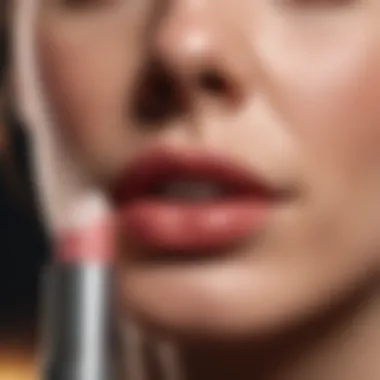Understanding Cold Sores and Chapstick Use


Intro
Cold sores, primarily caused by the herpes simplex virus (HSV), affect a significant portion of the population. Understanding the various factors that may influence outbreaks is essential, particularly for health-conscious individuals. The relationship between common lip care products like chapstick and the risk of triggering cold sores is a complex topic worthy of examination. By delving into the nuances of viral transmission, this article aims to clarify misconceptions surrounding chapstick usage and its potential impact on cold sore outbreaks.
Cold sores typically manifest as painful blisters around the lips, and their occurrence can be tied to several triggers such as stress, hormonal changes, and even excessive sun exposure. In this discussion, we will analyze how chapstick can play a role in either preventing or exacerbating these outbreaks, especially when unsafely shared. Moreover, we will explore safe lip care practices and outline preventive measures that can reduce the risk of infection.
Understanding the linkage between everyday products and viral infections enhances informed decision-making, particularly for those in health professions. This article will venture into the realm of lip care, surgical practices, and impart knowledge that could help avoid unnecessary outbreaks. By analyzing expert insights and research findings, readers will gain a comprehensive understanding of how to protect themselves amid prevalent health threats.
Key Takeaways
- Understanding Transmission: Cold sores are primarily caused by HSV. They are contagious and can spread through direct contact.
- Chapstick Usage: Using chapstick alone does not cause cold sores. However, sharing lip products can pose risks.
- Daily Habits: Keeping lip products individual to oneself may help minimize outbreaks.
- Viral Load: The quantity of the virus can determine the likelihood of transmission.
Key Statistics
- Approximately 67% of people globally are infected with HSV-1, which commonly causes cold sores.
- Surveys show that nearly 25% of individuals often share lip care products leading to potential infections.
Safe Lip Care Practices
To maintain optimal lip health and reduce the chance of cold sore outbreaks, consider the following actionable tips:
- Personal Use: Avoid sharing chapstick or lip gloss. Each person should use their own products to minimize risks.
- Regular Hygiene: Keeping your lips clean and moisturized can help prevent cracks that may lead to infections.
- Apply with Care: When applying lip products, use a cotton swab to avoid direct contact when possible.
- Monitor Symptoms: Be aware of any tingling or initial signs of cold sores. Early intervention may prevent full-blown outbreaks.
"The best way to prevent cold sore outbreaks is to minimize risk factors and maintain good hygiene practices alongside appropriate personal use of lip products."
By following these recommendations, individuals will be better equipped to protect themselves against cold sore outbreaks associated with chapstick usage. Without compromising on the joys of self-care, one can adopt practices that enhance health security.
Preamble to Cold Sores
The topic of cold sores is important because they are a common viral infection that affects many individuals at some point in their lives. This article explores the dynamics surrounding cold sores, specifically their potential relationship with lip care products like chapstick. Knowing about cold sores helps in recognizing their symptoms, triggers, and ultimately, in preventing outbreaks. For those who are health-conscious, being informed about cold sores can promote better lip care practices and avoidance of potential infection.
Defining Cold Sores
Cold sores, also known as fever blisters, are small, fluid-filled blisters that appear around the lips or mouth. They are caused by the herpes simplex virus, primarily type 1, although type 2 can also lead to oral herpes. Cold sores are typically characterized by itching, burning sensations, and then the formation of blisters, which eventually crust over. Understanding what a cold sore is helps individuals recognize its symptoms and differentiate them from other lip conditions.
Causes of Cold Sores
Cold sores are primarily triggered by the herpes simplex virus. This virus is highly contagious and can be transmitted through close personal contact, such as kissing or sharing utensils. Other causes include:
- Stress: Emotional or physical stress can weaken the immune system, making one more susceptible to outbreaks.
- Sunlight: Excessive exposure to sunlight can trigger cold sores.
- Hormonal changes: Fluctuations in hormones, particularly during menstruation, can lead to outbreaks.
- Illness or fever: A cold or other illness can compromise the immune system and open the way for the virus to reactivate.
Most importantly, understanding these causes allows individuals to identify and avoid triggers, which is essential for prevention.
Understanding Chapstick and Its Ingredients
Understanding the ingredients and functionality of chapstick is crucial for a thorough comprehension of its role in lip care. Chapstick, widely used to maintain lip moisture and protect against adverse environmental conditions, contains various components with specific purposes. Being aware of these ingredients aids consumers in making informed choices that align with their health goals. In this section, we will explore the common ingredients found in chapstick and delve into how they function to keep lips healthy.


Common Ingredients in Chapstick
Most chapsticks contain a blend of waxes, oils, and sometimes additional antioxidants or vitamins that serve distinct purposes. The primary ingredients typically include:
- Beeswax or Paraffin Wax: These serve as a protective barrier. They lock in moisture and prevent chapping.
- Petroleum Jelly: This is a popular moisturizing agent. It helps to create a waterproof barrier that retains lip hydration.
- Cocoa Butter or Shea Butter: These are added for their nourishing properties, providing essential fatty acids that help heal and soothe cracked lips.
- Flavoring Agents: These are often included for sensory experience, making application more enjoyable. However, they do not provide any therapeutic benefit.
- Preservatives: Such as parabens, to increase shelf life. Some consumers prefer products without these substances due to potential health concerns.
It's imperative for consumers to read labels carefully, especially for those with allergies or sensitivities. Knowing these ingredients helps individuals select products that best suit their needs and avoid those that may aggravate their conditions.
Functionality of Chapstick
The functionality of chapstick extends beyond mere moisture retention. It acts as a barrier against environmental factors such as wind and cold weather. The waxy consistency provides a protective layer that can prevent further moisture loss from the lips, which is especially important in dry climates.
Additionally, chapsticks with formulated oils help to nourish the lips deeply, contributing to their overall health. Some products may even include sun protection factors which guard against ultraviolet damage. This is crucial since prolonged exposure to sunlight can lead to dehydrated and damaged skin.
Moreover, many chapsticks offer additional benefits such as:
- Healing Properties: Ingredients like aloe vera, and vitamin E can aid in the healing process of cracked skin.
- Long-lasting Moisture: Specialized formulations help keep lips hydrated throughout the day, reducing the need for frequent reapplication.
- Convenience: The easy application makes it a go-to product for maintaining lip health on the go.
Through understanding both common ingredients and their functions, users can more effectively choose chapstick products that not only prevent cold sores but also promote overall lip health.
The Connection Between Chapstick and Cold Sores
The relationship between chapstick and cold sores is an important subject of discussion, mainly because lip care is such a routine part of many people's lives. Understanding how cold sores can be related to chapstick usage involves a closer look at the nature of the Herpes Simplex Virus and how it interacts with our everyday habits.
The primary concern for users is whether their chapstick can be a conduit for transmitting the virus that causes cold sores. Cold sores are not only a cosmetic concern but also an indicator of a viral infection that can carry significant discomfort and, in some cases, psychological distress. As such, knowledge about the relationship between these lip products and the virus can inform safer practices.
Though chapstick offers benefits like moisturizing and protection from environmental factors, it is crucial to recognize the potential risk of sharing or using contaminated lip products. By discussing this connection, we can provide readers with actionable advice on safe lip care practices.
Viral Transmission Mechanisms
Viral transmission is the cornerstone of understanding how cold sores appear. The Herpes Simplex Virus (HSV) is typically transmitted through direct contact with an infected individual. This may include kissing or sharing personal items like lip balm. Once the virus enters the body, it may remain dormant for long periods in the nerve cells.
In terms of transmission through chapstick, it can occur when an individual with an active outbreak uses their chapstick and then shares it with someone else. Even if the infected person does not have visible sores at the time, the virus can still be present in saliva or on the lip balm surface. This poses a risk especially in social situations where sharing products is common.
"Understanding viral transmission mechanisms is essential for making informed choices about lip care products."
Moreover, it is important to acknowledge that cold sores can be triggered by various factors, including stress and illness. This means even if someone hasn’t had an active outbreak for a while, they could still unwittingly transmit the virus at an inopportune moment.
Can Chapstick Spread Herpes Simplex Virus?
There is a common concern regarding whether chapstick can indeed spread the Herpes Simplex Virus. Based on research, the short answer is 'yes,' under certain conditions. If chapstick comes into contact with the virus, it can potentially carry it from one person's lips to another's.
This risk heightens in public settings where chapsticks are shared, such as during social gatherings or among close friends. In environments where lip products are regularly exchanged, the chances of spreading HSV increase.
Additionally, while most chapsticks have ingredients aimed at preventing chapping and protecting the lips, these properties do not serve as a barrier against viral transmission. Therefore, using your own product and avoiding sharing with others becomes a crucial habit to form.
Common Misconceptions About Cold Sores and Lip Products
Understanding the misconceptions related to cold sores and lip care products is crucial. Such beliefs can lead to unnecessary fears or unsafe practices. When discussing cold sores, many individuals have gaps in knowledge that contribute to the spread of misinformation. Believing that simple chapstick can lead to outbreaks without considering other factors can be misleading. Addressing these misconceptions allows individuals to make informed decisions about their lip care and health.
Myth versus Fact
One prevalent myth is that using chapstick can directly cause cold sores. This is not accurate. Cold sores are primarily caused by the herpes simplex virus. The misconception arises when individuals unknowingly share chapstick or apply it after touching an infected area. Therefore, the chapstick itself does not cause cold sores; rather, it is related to the habits of the user. Understanding the distinction between myth and fact is vital to prevent unnecessary panic.
Another common belief is that all lip products are contagious. In reality, it depends on the situation. If a person with an active outbreak shares their chapstick, there is a risk of viral transmission. However, if chapstick is used only by the individual and hygiene practices are followed, there is significantly less risk of spreading the virus. It is essential for individuals to evaluate their surroundings and consider their habits when using shared lip products.


Influence of Sharing Chapstick
The act of sharing chapstick has significant implications regarding cold sore transmission. When someone with an active infection uses their chapstick and then shares it, the risk of spreading the herpes simplex virus increases. Direct contact with the virus through lip products becomes a mode of transmission. This highlights the importance of personal responsibility in lip care practices.
"Always avoid sharing lip care products to minimize the risk of transmitting viruses that cause cold sores."
Even when the appearance of an outbreak is not present, the virus can still be active and transmissible. People often underestimate this risk. In addition to sharing, one should be cautious about using chapstick after touching the mouth or any contaminated surface. Always wash hands before applying lip products.
Preventive Measures to Avoid Cold Sores
Preventing cold sores is essential for maintaining healthy lips and avoiding discomfort. This section focuses on the specific measures individuals can take to reduce their risk of cold sore outbreaks.
Proper Usage of Chapstick
Chapstick serves as a vital barrier against moisture loss, especially during harsh weather. However, improper use can lead to concerns. Always apply chapstick directly to clean lips and avoid contact with the applicator on surfaces that may carry the herpes simplex virus. Consider using products with a twist-up format instead of sticks that require direct contact to minimize potential contamination. Refraining from applying your chapstick when you have a cold sore is paramount, as this can increase the risk of spreading the virus.
To ensure efficacy, check expiration dates and avoid using products that are past their prime. Also, mindful users should recognize that sharing chapstick can pose risks, so it is wise to avoid borrowing lip products, especially if someone has an active outbreak.
Avoiding Contamination
Contamination is a prominent concern when discussing the spread of cold sores. The herpes simplex virus can be transmitted through physical contact, and lip products are not exempt from this risk. To mitigate the chances of virus transmission, follow these guidelines:
- Do Not Share Lip Products: Sharing chapstick, lip gloss, or balm can easily transfer the virus from one person to another. It is safer to use personal lip care items.
- Wash Your Hands: Always wash your hands before applying lip products. This reduces the chance of spreading any germs or viruses to your lips.
- Store Lip Products Properly: Keep chapstick and similar products in a clean, dry environment. Avoid carrying them in places where they can pick up dirt or bacteria.
- Replace Regularly: Discard any chapstick that has touched a cold sore, as it can retain the virus and cause reinfection.
By prioritizing these preventive measures, individuals can significantly reduce their risk of cold sores while enjoying the benefits of lip care products. Staying informed and cautious about usage and sharing practices is key in maintaining good lip health and overall well-being.
It's important to remember that prevention requires ongoing diligence. Regularly assessing personal health and habits related to lip product use can go a long way in avoiding outbreaks.
Recommended Lip Care Products
Lip care products play a vital role in maintaining lip health, especially for individuals concerned about cold sores. South of the equator and North alike, cold sores can be triggered by a variety of factors such as stress, sunlight, or illness. Using recommended lip care products can offer protective benefits while decreasing the chance of viral outbreaks. Whether it’s for prevention or soothing existing conditions, the right product matters.
Therapeutic Lip Balms
The first category of recommended products is therapeutic lip balms. These balms often contain ingredients specifically designed to aid in healing and moisture retention. Common components include salicylic acid, which helps in exfoliating dead skin, and petrolatum, serving as a barrier to lock in hydration. Additionally, healing agents like aloe vera and hyaluronic acid can nurture and soothe the lips. Selecting a therapeutic balm can provide multiple benefits:
- Moisturizing effects, reducing dryness.
- Soothing irritated skin.
- Offering a protective barrier against external elements.
When applying therapeutic lip balms, pay attention to the specific needs of your lips. Opting for products with SPF can further shield against sun exposure, a known trigger for cold sore outbreaks. Brands like Aquaphor and Abreva offer formulations that combine soothing properties with healing ingredients. Always read labels to ensure that you understand what each component does, choosing products that specifically mention cold sore prevention or relief.
Natural Alternatives
For those concerned about chemical ingredients or prefer natural approaches, there are effective alternatives available. Natural lip care products typically leverage oils and botanical extracts for hydration and healing. Coconut oil, shea butter, and beeswax are prominent in this category, providing nourishment without harsh additives. Here are some remarkable benefits of natural alternatives:
- They are generally gentler on sensitive skin.
- Often free from synthetic fragrances and preservatives.
- They can be more environmentally friendly in their sourcing and packaging.


Herbal remedies, such as tea tree oil or lavender oil, can also be included in your lip care routine. However, these should be diluted before direct application to prevent skin irritation. Natural products may take more time to yield visible results compared to therapeutic formulations, so patience is essential when choosing this path.
"Choosing the right lip care product can directly affect your skin's well-being, particularly in preventing outbreaks of cold sores."
In summary, whether selecting therapeutic lip balms or natural alternatives, ensuring that these products are used regularly can help maintain lip health and potentially minimize the risk of cold sore occurrence.
When to Consult a Healthcare Professional
In the context of cold sores and chapstick usage, recognizing when to seek professional medical advice is crucial. Cold sores may seem like a minor inconvenience, but they can have a significant impact on quality of life. Understanding the right circumstances for consulting a healthcare expert ensures effective management of symptoms and preventative care for future outbreaks.
Symptoms of Cold Sores
Cold sores are typically characterized by a few specific signs. Early symptoms may include tingling and itching around the lips or mouth area. Often, this is followed by the appearance of blisters, which can be painful and fluid-filled. These blisters tend to break easily, leading to crusting and the formation of scabs. Below are some important indicators that signal you should consider medical consultation:
- Persistent Symptoms: If you notice that blisters are lingering longer than usual, it may indicate a more serious underlying issue.
- Frequent Outbreaks: Recurring cold sores, especially if they happen more than four times a year, should prompt a visit to a healthcare provider.
- Severe Pain: Intense pain around the outbreak site can also be a reason to seek help.
- Fever or Flu-Like Symptoms: Sometimes, cold sores may coincide with systemic symptoms like fever or fatigue. This could suggest that the body is fighting beyond just a localized outbreak.
Getting timely help can lead to appropriate treatments, like antiviral medications, which can reduce the severity and duration of these outbreaks.
Seeking Medical Advice
Consulting a healthcare professional regarding cold sores is advisable for several reasons. First, it helps clarify diagnosis and treatment options. Cold sores are caused by the herpes simplex virus, and there are several strains. A medical expert can determine the most suitable treatment for your specific situation.
When preparing for a consultation, consider the following points:
- Document Symptoms: Keep a record of when outbreaks occur, their duration, and any accompanying symptoms. This information will help the professional assess your condition better.
- List Past Treatments: Mention any previous treatments you have tried and their effectiveness. This detail can guide the healthcare professional in recommending new strategies.
- Discuss Lifestyle Factors: Factors such as stress, sun exposure, and dietary habits can influence cold sore outbreaks. Being open about these aspects enables a holistic approach to care.
Timely consultation with a healthcare professional not only aids in immediate relief but also fosters long-term management strategies. Managing cold sores effectively can prevent complications, including risk of spreading the virus to others, especially through shared items like chapstick.
"Seeking medical advice is not just about managing a sore; it’s about understanding and navigating the health implications associated with the herpes simplex virus."
Culmination: Key Takeaways on Lip Care and Cold Sores
The relationship between chapstick and cold sores presents significant considerations for health-conscious individuals. Understanding this connection can guide better lip care practices. This discussion covers important elements related to cold sores and emphasizes the necessity of a protective regimen for lips.
Cold sores, caused primarily by the herpes simplex virus, can be triggered by various factors, including stress and sun exposure. By being aware of how lip products may interact with these triggers, individuals can take informed steps to minimize risks.
Summary of Findings
Research shows that cold sores are not directly transmitted via chapstick. Instead, the herpes virus spreads through direct contact with infected skin or secretions. Some key points include:
- Viral Transmission: The herpes simplex virus usually spreads through intimate contact. Sharing chapstick may not directly transmit the virus, but contamination is a risk.
- Common Misconceptions: Myths about chapstick spreading cold sores persist. It is generally safer to use personal lip care products exclusively.
- Contamination Prevention: Maintaining hygiene with lip products is crucial to avoid potential outbreaks.
The importance of understanding these factors cannot be understated. Recognizing how environmental influences and product sharing relate can lead to healthier decisions.
Final Recommendations
To foster better lip care and avoid cold sores, consider the following recommendations:
- Use Personal Products: Avoid sharing your chapstick or lip balm to maintain hygiene.
- Adopt Hygiene Practices: Always clean your hands before applying lip products. This reduces potential contamination.
- Be Mindful of Triggers: Identify and manage personal triggers for cold sores. Stress management and sun protection play vital roles in prevention.
- Select the Right Products: Choose high-quality chapsticks that contain soothing and protective ingredients.
"Preventive measures remain the most effective approach to managing viral risks associated with lip care products."
By taking the necessary precautions, individuals can navigate the complexities of lip care while minimizing the risk of cold sore outbreaks.







